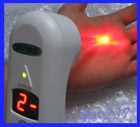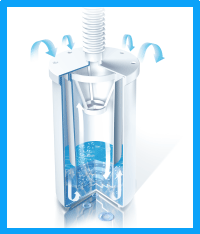Acupuncture
What is acupuncture?
Acupuncture literally means 'needle piercing," the practice of inserting very fine needles into the skin to stimulate specific anatomic points in the body (called acupoints or acupuncture points) for therapeutic purposes. Along with the usual method of puncturing the skin with the fine needles, the practitioners of acupuncture also use heat, pressure, friction, suction, or impulses of electromagnetic energy to stimulate the points. The acupoints (acupuncture points) are stimulated to balance the movement of energy (qi) in the body to restore health.
Acupuncture involves stimulating. In the past 40 years acupuncture has become a well-known, reasonably available treatment in developed and developing countries. Acupuncture is used to regulate or correct the flow of qi to restore health.
To really understand how acupuncture works, it is necessary to become familiar with the basics of Chinese philosophy. The philosophies of the Dao or Tao, yin and yang, the eight principles, the three treasures and the five elements are all fundamental to traditional Chinese acupuncture and its specific role in helping to maintain good health and a person's well-being.
Acupuncture and Traditional Chinese Medicine:
The Philosophy of the Dao
Dao is often described as "the path" or "the way of life" in Traditional Chinese Medicine (TCM) and acupuncture, just as its counterpart in ancient India, Ayurveda. The laws of the Dao advocate moderation, living in harmony with nature and striving for balance. Ancient Chinese believed that moderation in all areas of life is essential to a long and fruitful life. We are "fueled" by three treasures: Qi or Chi (pronounced chee), Shen, and Jing. Chi is energy or vital substance, Shen is the spirit, and Jing is our essence. Qi is both the life force (or vital substance) and the organizing principle flowing through all things and establishing their interconnectedness. Chinese believe that every living thing (both human and non-human) has qi. In the body, qi is found in the heart and lungs in circulating blood and oxygen. Shen is the treasure that gives brightness to life and is responsible for consciousness and mental abilities. Sometimes it is compared to soul. Within the individual shen is manifested in personality, thought, sensory perception, and the awareness of self. Jing is responsible for growth, development and reproduction. Jing represents a person's potential for development. (comparable to western concept of genetical inheritance). Chinese believed that everyone is born with a finite amount of Jing. As we go through life, we lose or consume our Jing little by little. Once we lose Jing, it cannot be replaced. It is gone for ever. We lose Jing if we live a wrong or careless living. But Jing can be preserved if we live in moderation. Acupuncture can reduce the loss of Jing.
Role of Acupuncturist in Traditional Chinese Medicine
According to the philosophy of Dao, the role of the acupuncturist is to restore your health and enable you to live a little closer to the Dao, thus preserving your Jing and living to a ripe old age. A number of factors can contribute to the depletion of Jing. Living a life of excess, drinking too much, excessive emotional reactions, working too hard, inappropriate sexual behavior, etc. all were believed to result in the depletion of Jing. Balance in all things was considered the key to good health and long life.
In order to increase their understanding of the Dao, the Chinese developed two concepts that together form the basis of Chinese thought: yin and yang and the more detailed system of the five elements.
Yin and Yang in Acupuncture and in Traditional Chinese Medicine (TCM)
The idea of harmony and balance are also the basis of yin and yang. The principle that each person is governed by the opposing, but complementary forces of yin and yang, is central to all Chinese thought. It is believed to affect everything in the universe, including ourselves.
Yin-Yang Symbol (Tai Chi symbol)
Traditionally, yin is dark, passive, feminine, cold and negative; yang is light, active, male, warm and positive. Another simpler way of looking at yin and yang is that there are two sides to everything - happy and sad, tired and energetic, cold and hot. Yin and yang are the opposites that make the whole. They cannot exist without each other and nothing is ever completely one or the other. There are varying degrees of each within everything and everybody. The tai chi symbol, shown above, illustrates how they flow into each other with a little yin always within yang and a little yang always within yin. In the world, sun and fire are yang, while earth and water are yin. Life is possible only because of the interplay between these forces. All of these forces are required for the life to exist.
See the table below to understand the relationship between yin and yang:
H E A L T H
L i v e a g r e a t l i f e
Yin Forces/Aspects
|
Yang Forces/Aspects
|
Dark
|
Light
|
Light
|
Light
|
Water Fire
|
Fire
|
Passive
|
Active
|
Descending
|
Ascending
|
Female
|
Male
|
Contracting
|
Expanding
|
Cold
|
Hot
|
Winter
|
Summer
|
Interior
|
Exterior
|
Heavy
|
Light
|
Bone
|
Skin
|
Front
|
Back
|
Interior of Body
|
Exterior of body
|
The yin and yang is like a candle. Yin represents the wax in the candle. The flame represents the yang. Yin (wax) nourishes and supports the yang (flame). Flame needs the wax for its existence. Yang consumes yin and, in the process, burns brightly. When the wax (yin) is gone, the flame is gone too. Ying is also gone at that time. So, one can see how yin and yang depend on each other for their existence. You cannot have one without the other.
The body, mind and emotions are all subject to the influences of yin and yang. When the two opposing forces are in balance we feel good, but if one force dominates the other, it brings about an imbalance that can result in ill health.
One can compare the concept of yin and yang to the corresponding principle of tridoshas in Ayurveda, the ancient remedy from India. Ayurveda proposes that every person has vata, pitta and kapha. When these are balanced, there is the state of perfect health. When there are imbalances then there is disease.
One of the main aims of the acupuncturist is to maintain a balance of yin and yang within the whole person to prevent illness occurring and to restore existing health. Acupuncture is a yang therapy because it moves from the exterior to the interior. Herbal and nutritional therapies, on the other hand, are yin therapies, as they move from the interior throughout the body. Many of the major organs of the body are classified as yin-yang pairs that exchange healthy and unhealthy influences.
Yin and yang are also part of the eight principles of traditional Chinese medicine. The other six are: cold and heat, internal and external, deficiency and excess. These principles allow the practitioner to use yin and yang more precisely in order to bring more detail into his diagnosis.
The Five Elements in Chinese Philosophy
The yin and yang philosophy was further refined into the system of the five elements to gain a deeper understanding of how the body, mind and spirit work and acupuncture.
The microcosm of the body is linked to the universe and is affected by the daily and seasonal cycles of nature. (Think about the seasonal affective disorder which manifests itself in winter or when the light is not sufficient). The individual and the world are changing all the time. But Chinese believe that these changes are occurring in certain order and in cycles. (We can think about these like our economic cycles or agricultural cycles. A period of growth is always followed by a period of stagnation or unemployment. In the stock market, a bull market is always followed by a bear market etc.) In the same way, a seed planted in spring blooms in summer, seeds itself in late summer to autumn, dies in winter, and a new seed grows again in spring. It is part of a never-ending cycle and each phase has its role to play in maintaining the balance of nature. The same process of change occurs within the body. Cells grow and die to make way for new cells, and body systems depend upon each other in a similar way to the seasons, working together to ensure the balanced functioning of the body, mind and spirit and the healthy flow of life through the whole person.
Representation of the Five Elements
Chinese philosophy recognizes five distinct elements of cyclical change called water, wood, fire, earth, and metal. These five elements can be related to our four seasons (with a fifth late summer season) as shown in the table below. The elements can also be related to different colors, emotion, taste, voice and various organs. These can also be related to the selection of food and herbs. Notice the correspondence between the Chinese philosophy and the underlying Indian philosophy, which also classifies everything in the universe under earth, water, fire, air, and ether.
Season Element Yin-Yang Phase Yin Organ Yang Organ Energy Pattern Color Emotion Taste Voice
Winter Water Full yin Kidney Urinary bladder Conserved Black Fear Salty Groans
Spring Wood New yang Liver Gallbladder Expansive Green Anger Sour Shouts
Summer Fire Full yang Heart Small Intestine Culmination,completion Red Joy Bitter Laughs
Late Summer Earth yin-yang balance Spleen Stomach Balance Yellow Sympathy Sweet Sings
Autumn Metal New yin Lungs Large Intestine Contraction and accumulation White Grief sadness Pungent Weeps
Each person's physical and mental constitution can be described as a balance of the elements in which one or more may naturally dominate. The proportion of the elements in a person determines his or her temperament. Oriental medicine considers the ideal condition as one in which all the five elements are in balance or in harmony. Wood is said to be the mother of fire and the son of water. (Water allows wood to grow, wood provides fuel for the fire). Using these relationships one can describe all possible yin-yang imbalances within the body. The thrust of five element diagnosis is to isolate and treat the imbalanced element, because an imbalanced element is like a weak link in your energetic chain that can undermine the strength of your mind, body and spirit.
Element Universe Individual
Wood Growing, flourishing, rooted yet pushing upward Striving, controlling, flexible strength, self-assured
Earth Productive, fertile Solid, stable, reliable, tenacious, grounded
Metal Hard, structured, symmetric Organized, substantial, strong, durable
Fire Dry, hot, ascending Dynamic, sparkling, enthusiastic
Water Wet, cool, descending Flowing, adaptable, pliant

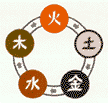
How the Imbalance of the Elements Affect Us?
Imbalance
|
Meaning
|
Symptoms
|
Too low fire - not warming the earth
|
Heart (fire) unable to warm spleen (earth)
|
(earth) Dislike of cold, cold in extremities, early morning diarrhea, urinary symptoms, edema, distended abdomen, fatigue, weakness
|
Too low metal - metal not producing water
|
Lungs (metal) not sending water to kidney
|
Shortness of breath, thirst, weak knees, lower back pain, scanty dark urine.
|
Too much wood - Wood overpowers the earth
|
Liver (wood) qi dominates spleen (earth)
|
Headache, sore eyes, gas, poor appetite, weakness, pain in flanks, vertigo, chest distress
|
Too much metal - Fire cannot control metal
|
Heart (fire) yang cannot control lung (metal) fluids
|
Frequent urination, shortness of breath, palpitation, insomnia
|
Healing Applications of Acupuncture
Acupuncture is best known for the control of pain. However, acupuncture can treat a wide variety of common and uncommon disorders. The following is a list of disorders that can be treated by acupuncture (World Health Organization data):
Respiratory
Acute Sinusitis
Acute rhinitis
Common cold
Acute tonsillitis
Acute bronchitis
Bronchial asthma
Eye
Acute conjunctivitis (pinkeye)
Nearsightedness (in children)
Cataract (without complications)
Mouth
Toothache, post extraction pain
Gingivitis (gum disease)
Acute and chronic pharyngitis
Gastrointestinal Disorders
Hiccups
Gastritis
Gastric Hyperacidity
Ulcers
Colitis
Constipation
Diarrhea
Paralytic ileus
Neurological and Musculoskeletal Disorders
Headache and migraine
Trigeminal neuralgia
Paralysis following stroke
Meniere's disease
Neurogenic bladder dysfunction
Nocturnal enuresis (bed wetting)
Intercostal neuralgia (pain in the ribs)
Cervicobrachial syndrome (pain radiating from neck to arm)
Frozen shoulder or Tennis elbow
Sciatica
Low back pain
Osteoarthritis
In the United States, acupuncture is used frequently for the treatment of chronic pain conditions such as arthritis, bursitis, headache, athletic injuries, and posttraumatic and post surgical pain. It is also used for treating chronic pain associated with immune function dysfunction such as psoriasis (skin disorders), allergies, and asthma. Acupuncture is also found to be effective for the treatment of mind-body disorders such as anxiety, chronic fatigue, irritable bowel syndrome, hypertension, insomnia, PMS, menopausal symptoms, and depression. Some modern application of acupuncture is in the treatment of disorders such as alcoholism, addiction, smoking, and eating disorders.
Channels or Meridians in Acupuncture - The invisible Pathways of Qi
Chinese use the term "jing luo" which means, channels, conduit, meridian etc. According to acupuncture, these are the invisible channels through which qi circulates throughout the body. The acupuncture points (or holes as the Chinese term xue is more aptly translated means) are the locations where the qi of the channels rises close to the surface of the body. There are 12 main meridians, six of which are yin and six are yang and numerous minor ones, which form a network of energy channels throughout the body.
In acupuncture, each meridian is related to, and named after, an organ or function, the main ones are: the lung, kidney, gallbladder, stomach, spleen, heart, small intestine, large intestine, gall bladder, urinary bladder, san jiao (three heater) and pericardium (heart protector/ or circulation sex meridian).
There are also 8 extraordinary channels in acupuncture that are considered to be reservoirs supplying qi and blood to the twelve regular channels. These are believed to have a strong connection to the kidney. The meridians are shown in the figures.
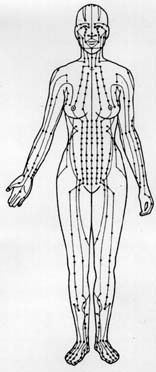
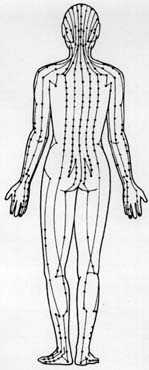
Location of the meridians and acupoints (acupuncture points) in the body.
Dotted along these meridians are more than 400 acupuncture points, classified by WHO. (There may be as many as 2000 points in use for different treatments.) These are listed by name, number and the meridian to which they belong.
When Chi flows freely through the meridians, the body is balanced and healthy, but if the energy becomes blocked, stagnated or weakened, it can result in physical, mental or emotional ill health. An imbalance in a person's body can result from inappropriate emotional responses such as: excess anger, over-excitement, self-pity, deep grief and fear. Environmental factors such as cold, damp/humidity, wind, dryness, and heat can also cause imbalance so as factors such as wrong diet, too much sex, overwork and too much exercise.
To restore the balance, the acupuncturist stimulates the acupuncture points that will counteract that imbalance. So, if you have stagnant Chi, he will choose specific points to stimulate it. If the Chi is too cold, he will choose points to warm it. If it is too weak, he will strengthen it. If it is blocked, he will unblock it, and so on. In this way, acupuncture can effectively rebalance the energy system and restore health or prevent the development of disease. The points that the practitioner chooses to stimulate may not necessarily be at the site of the symptoms.
How Does Acupuncture Work?
Historically, acupuncture points were believed to be holes that allow entry into channels. These holes provide us gateways to influence, redirect, increase, or decrease body's vital substance, qi, thus correcting many of the imbalances. Many studies and research were directed since to understand the mechanism of acupuncture.
Effects of Acupuncture
Acupuncture has been shown to stimulate the immune system. It also has affects the circulation, blood pressure, rhythm and stroke volume of the heart, secretion of the gastric acid, and production of red and white cells. It also stimulates the release of a variety of hormones that help body to respond to injury and stress.
The Gate Control Theory of Pain
According to this theory, pain signals must pass through a number of high-traffic "gates" as they move from the area of injury upward through the spinal cord into the brain. Like a road or highway, these nerves can handle only a limited number of nerve signals at one time. The pain signals travels very slowly. We can generate other signals which move faster. The faster signals crowd out the slower ones because of the limited capacity of the nerves. (Remember the time sitting in traffic near a construction zone, where the two lanes merge into one. The fast cars on the merging lanes go further and merge ahead of the slower ones, making it nearly impossible for the slow traffic on the lane to move forward. Now think about the pain signals are the slow ones sitting there waiting for an opening to move through. If one can produce enough fast signals, it can effectively crowd out the pain signals.) Acupuncture generates competing stimulus and effectively blocks the slow pain signals from reaching the brain. The result: we never "experience the pain".
Electrical Theory of Pain
The body continually generates tiny but detectable electrical discharges. This electrical field influences the growth, maturation, and functioning of some types of cells. It is known that acupuncture points are concentrated in regions of low electrical resistance. Studies have shown that there is a correlation between the electromagnetic fields in the body and the channels or meridians. So, this electrical theory of acupuncture suggests that acupuncture works by influencing the body's electromagnetic fields. Acupuncture points have certain electrical properties, and stimulating these points alters chemical neurotransmitters in the body.
Clinical Trials of Acupuncture
Acupuncture is one of the most thoroughly researched and documented of the alternative medical practices. A series of controlled studies has shown evidence for the effectiveness of acupuncture in the treatment of a variety of conditions, including osteoarthritis, chemotherapy-induced nausea, asthma, back pain, painful menstrual cycles, bladder instability, and migraine headaches. Studies on acupuncture also have shown positive results in the areas of chronic pain management and in the management of drug addition, two areas where conventional Western medicine is very limited.

